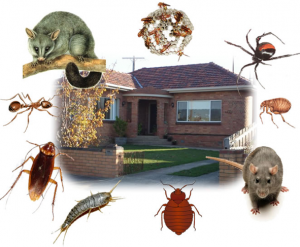Nobody Likes a Pest!
 Everyone wants to keep their homes safe. But even the best alarm system can’t keep out the smallest of home intruders: the pest. Nobody likes a pest, especially the creepy, crawly kind. But they exist, and, unfortunately, too many of us make it easy for pests to take up residence right alongside the family.
Everyone wants to keep their homes safe. But even the best alarm system can’t keep out the smallest of home intruders: the pest. Nobody likes a pest, especially the creepy, crawly kind. But they exist, and, unfortunately, too many of us make it easy for pests to take up residence right alongside the family.
To help you remember the most effective way to deal with pests, use these tips:
Investigate. Take a serious, strategic approach to discovering potential pest problems in and around your home.
Study. After identifying potential problems, study the potential cause or consequence of these problems.
Prepare. Plan how to most effectively solve your problem. Changing habits to include covering your dryer vent, and only eating in the kitchen can help prevent pests from taking up residence.
Eliminate. Eliminate pest entryways into your home by caulking cracks and trimming trees and shrubs.
Clean. Maintaining your home and lawn are essential for discouraging pests from calling your home theirs. Eliminate opportunities for pests to find food, water, and nesting and hiding places.
Treat. To protect your home and family, properly treat pest problems with the appropriate pesticide product to effectively manage the problem.
Room by Room
While pests can be in any part of your home, here are some of the more common rooms you’ll find them in, and what you can do to keep them out.
Bedroom
Common Pests: Bed bugs, dust mites
Bed bugs can live anywhere in any home. They tend to concentrate in mattresses, box springs and bed frames, but they can also be in curtains, inside furniture drawers, and in cracks in the wallpaper. They can even hitch a ride on clothing or in a backpack and be carried to and from school.
Bed bugs can live for a year or more without feeding, and can withstand temperatures that range from nearly freezing to almost 113°F. Managing a bed bug infestation is difficult and requires professional help, which can include close inspection and monitoring, and possibly removal of all infested materials.
Tips:
• Check mattresses, headboards and box springs for signs of beg bug droppings, eggs or live nymphs.
• Regularly inspect backpacks for signs of bed bugs.
• If you suspect a bed bug infestation, contact a licensed pest management professional for an immediate inspection.
Dust mites thrive in warm, humid conditions. They are found in mattresses, furniture, toys, curtains, carpets and rugs. They can trigger asthma, cause dermatitis, and transmit disease.
Tips:
• Cover mattresses and pillows with dust-proof, zippered covers tested and rated for dust mites.
• Frequently change bed linens. Wash bedding and stuffed animals once a week.
• Vacuum areas frequently.
• Ask a pest management professional for help treating for dust mites.
Bathroom
Common Pests: Spiders, silverfish
Spiders like to lurk in corners, cabinets and drawers, as well as clothing and behind curtains. If you have a persistent spider problem, it’s most likely that you also have other pests that are serving as a steady food source for spiders.
Tips:
• Remove webs with a broom or vacuum. Destroy any egg sacs you find. Check around windows, in corners or other out of the way spots.
• Check for leaking water lines under the sink and in the shower/tub area.
• Clean faucets and shower heads.
• Supplement cleaning with proper insecticide treatment. Treat around baseboards, in cracks and crevices and other likely hiding places.
Silverfish like to chew on anything with starch or polysaccrides — paper, photos, hair, wallpaper, carpet, clothing and even dandruff.
Tips:
• Eliminate sources of water. Fix leaky faucets, and don’t let water stand in the tub or sink.
• Replace or repair moldy or wet wood in the bathroom.
• Reduce humidity in the bathroom by running a fan or opening a window while you shower.
Kitchen
Common pests: Ants, roaches, rodents
Insects and rodents look for food anywhere they can find it — cabinets, pantries, floorboards, areas where pet food is stored. These pests contaminate food and carry disease.
Tips:
• Maintain clean, clutter-free spaces.
• Wipe up spills and pick up crumbs immediately.
• Keep stove vents and drip pans clean.
• Store food in air-tight and pest-proof containers, or in the refrigerator or freezer.
• Don’t leave your pet’s food and water dishes out overnight.
• Check for water leaks under the sink and refrigerator.
• Keep trash and recycling areas clean, and rinse out food containers and beverage cans before disposing of them.
• Baits, sprays and traps are effective ways to manage kitchen pests.
Source: www.debugthemyths.com.
Call us today to view our new home plans: 713-539-0048 – Sign up for our New Home Buying Tips
Visit our website: www.fairmontfarm.wpengine.com
Tour our model homes – View our available new home floor plans – View our photo gallery


Sorry, the comment form is closed at this time.